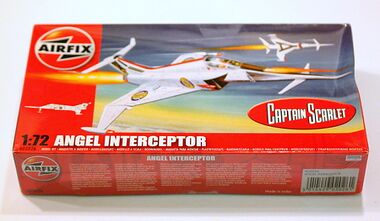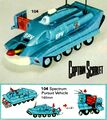Category:Captain Scarlet
| Gerry Anderson |
|---|
Captain Scarlet |
| 1967 - 1968 |
| | Supercar | Fireball XL5 | Stingray | Thunderbirds | Captain Scarlet | Joe 90 | UFO | Space 1999 | |
1968: Spectrum Pursuit Vehicle [image info]
1969: "Captain Scarlet's Terrific Trio" [image info]
Dinky 103: Spectrum Patrol Car [image info]
Dinky 104: Spectrum Pursuit Vehicle [image info]
Dinky 104 features [image info]
Dinky 105: Maximum Security Vehicle [image info]
Airfix "Angel Interceptor" plastic kit A02086 [image info]
Captain Scarlet and the Mysterons (normally just referred to as Captain Scarlet) was a marionette-based television series produced by Gerry Anderson.
The concept of Captain Scarlet was that an Earth exploration of Mars had accidentally made enemies of the local Mysterons, strange disembodied entities whose presence was represented by a ring of light that passed eerily over objects ... a brilliant idea that probably allowed an "alien" to be implemented with a slide projector and a slide of a white outline circle. As with UFO, the plots revolved around an organisation tasked with defending the Earth, this time called SPECTRUM. Spectrum was headed by a Captain White, Captain Scarlet was part of the organisation, and a certain amount of his time was spent trying to combat the actions of villain and saboteur Captain Black.
The Mysterons had the ability to possess obects by recreating them after they had been destroyed. Captain Scarlet is initally killed by the Mysterons and recreated as a Mysteron agent, but (unlike Captain Black) his recreated double is somehow independent of the Mysteron's control, and continues to work for SPECTRUM, with the added bonus of now being indestructable.
Episodes typically reached a climax with Captain Scarlet heroically losing his life in an attempt to save the situation ... and then miraculously turning out not to be dead after all.
Notable Hardware
Cloudbase
- The high-altitude hovering airstrip and command centre for Spectrum.
Angel Interceptors
- ... were distinctive thin white dartlike fighter-planes operating out of Cloudbase, with female pilots having "Angel" codenames. The logic behind having an all-female fighter pilot squadron was presumably the very small cockpit size of the interceptors. The thin, narrow shape of the aircraft meant that contemporary models tended to be in the form of plastic kits rather than diecast models.
SPVs, or Spectrum Pursuit Vehicles
- ... were heavily-armoured blue high-speed cars relying on cameras for driver visibility rather than windows, that looked something like a cross between a supercar and a tank. Drawing on contemporary ideas about vehicle safety and crash survivability, the SPV driver was rear-facing, and using a screen: if the car crashed at speed, the driver would be forced back into their passed chair rather than thrown forward.
SPCs, or Spectrum Patrol Cars
- ... were similarly styled cars, without the armour and with normal windowing, bright red and with a central vane.
MSVs, or Maximum Security Vehicles
- ... were broadly similar to SPV's but white, without the weaponry, and with gullwing doors.
Criticisms
Given that Captain Scarlet's main superpower was the ability to repeately die with no obvious long-term side-effects, not everyone was convinced that it was a good idea to combine puppetry (which suggested that this was supposed to be a show aimed at small children) with plotlines that essentially involved the heroic death of the main character every week. Given that small children have a propensity for acting out the behaviour of their heroes, worries about copycat behaviour may have made television companies more reluctant to show repeats of Captain Scarlet, rather than other "safer" shows like Thunderbirds.
There was also the problem that the viewer essentially knew in advance what the climax of every episode was likely to be, and that the main character was probaby never in any real danger.
External links
Media in category ‘Captain Scarlet’
The following 9 files are in this category, out of 9 total.
- Angel Interceptor kit, Captain Scarlet, box (Airfix A02086).jpg 1,200 × 699; 657 KB
- Captain Scarlet, logo.jpg 1,600 × 933; 91 KB
- Gerry Anderson Dinky Toys (DinkyCat12 1976).jpg 2,200 × 849; 443 KB
- Maximum Security Vehicle, Dinky Toys 105 (DinkyCat 1971).jpg 3,000 × 1,581; 457 KB
- Spectrum Patrol Car, Dinky Toys 103 (DinkyCat 1971).jpg 3,000 × 1,519; 414 KB
- Spectrum Pursuit Vehicle, Dinky Toys 104 (DinkyCat 1971).jpg 3,000 × 1,351; 501 KB
- Spectrum Pursuit Vehicle, Dinky Toys 104 (DinkyCat12 1976).jpg 1,954 × 2,200; 685 KB
- Spectrum Pursuit Vehicle, Dinky Toys 104 (MM 1968-02).jpg 3,000 × 1,451; 620 KB
- Three Captain Scarlet vehicles (MM 1969-03).jpg 3,000 × 1,796; 828 KB


















